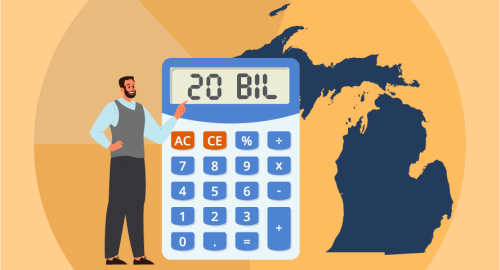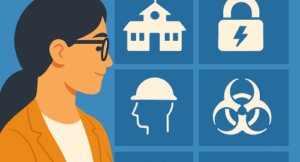Listen to this blog
7 minutes
The school shooting at Oxford High School on November 30, 2021, prompted Governor Whitmer and the Michigan Legislature to expand the state budget for school safety.
In a recent webinar, Raptor was joined by Diane Golzynski, PhD, RDN, SNS with the Michigan Department of Education, and Mike Malane, Partner at Midwest Strategy Group and former Chief of Staff in the Michigan State Senate, to discuss the approximately $20B Michigan budget for K-12 schools. Click here to watch the full on-demand webinar.
What’s included in the budget?
The budget is focused on addressing physical and technological gaps for safety and security as well as preventative measures like providing funding for mental health resources and support for at-risk/economically disadvantaged students. In 2018, Dr. Golzynski stated the state had zero dollars in state investment for mental health, and since then, the budget for school safety and mental health has grown to over $700 million. The following are a few examples of what’s included in the 2022-2023 historic budget:
- $2.5 billion in federal funds related to the COVID-19 pandemic
- $25 million for school resource officers
- $150 million in per-pupil grants for activities to improve student and staff mental health, including hiring of support staff
- $168 million in school safety funding
- $50 million in federal funding for intermediate school districts to implement a TRAILS (Transforming Research into Action to Improve the Lives of Students) program to improve mental health services
- $747.5 million for students considered “at risk” due to economic disadvantages
School Safety Funding
“This estimated $109 per student can be spent on anything the district can justify as being related to student safety and security within a building”, said Dr. Golzynski. “This includes school safety services and products necessary to improve or maintain security in buildings.”
Funding has been allocated through Section 97 of the State School Aid Act for the 2022-2023 school year for districts and nonpublic schools to improve school safety. Funding will be dispersed on a per pupil basis, currently estimated to be $109.00 per pupil. Examples of allowable expenditures include:
- Coordination with local law enforcement
- Training for school staff on threat assessment and crises communication
- Training for school staff and students on threat response
- Safety infrastructure
- Any other school safety service or product necessary to improve or maintain security in buildings
The funding is open to all public schools, charter schools, private schools, intermediate school districts, and the Michigan School for The Deaf.
A state supplemental from earlier this spring also introduced Section 97c which provides $10 million for schools to conduct safety assessments and 97d which provides $12.5 million for critical incident mapping. The results of a safety assessment could reveal schools’ vulnerabilities and how the money they receive from the school safety funds could help them address these gaps.
Mental Health Funding
“Mental health needs are getting greater and greater. The Legislature, the Governor, and everyone involved recognizes that we need more resources,” stated Mike Malane. “We need the ability to reach these kids before we ever get to the point of a critical incident.”
Section 31aa of the State School Aid Act provides $150 million for the 2022-2023 school year to districts for activities to improve student mental health. The allowable expenditures include:
- Hiring or contracting for support staff for student mental health needs
- Purchasing and implementing mental health screening tools
- Providing school-based mental health personnel access to consultation with behavioral health clinicians to respond to complex student mental health needs
- Any other mental health service or product necessary to improve or maintain the mental health of students and staff
Task Force Recommendations
A school safety task force, consisting of 8 members from across the state, was set up in the immediate aftermath of the Oxford shooting. The task force has put together a package of recommendations that are now turning into bills that cover a wide range of issues for both school safety and mental health. Recommendations include:
- Improving access and communication with the Okay2Say tipline
- Providing incentives for additional school counselors
- Refining active shooter drill requirements
- Standardizing floorplan maps for all schools
- Requiring ongoing safety training for school resource officers
- More robust mental health services
School Safety Solutions to Consider
From school safety drills to supporting the mental wellbeing of individual students, the following are some best practices to keep your staff and students safe:
- SCHOOL SAFETY DRILL BEST PRACTICES: A drill management system is key to analyzing drill performance, maintaining compliance, and creating muscle memory for a real-life emergency.
- SCHOOL EMERGENCY RESPONSE BEST PRACTICES: Successful response—and the number of lives saved—depends on how fast first responders receive accurate, specific information about the emergency.
- BEST PRACTICES FOR REUNIFYING STUDENTS AND RECOVERING: Alongside how to respond to an incident, you also need a robust plan for every component of reunifying students with their guardian.
- BEST PRACTICES FOR SUPPORTING STUDENT WELLBEING: Learn Strategies to Support Students in Distress and Reduce Violence in Schools.
Contact a school safety software expert to learn more about how your district can address vulnerabilities in your safety ecosystem.
Related Resources
Guide to K-12 Student Wellbeing
Strategies to Recognize, Document, and Support Students in Distress
Listen to this blog
7 minutes








